

How Predictive Analytics Transforms Hyper-Personalization into Better Experiences






Personalized experiences are no longer optional. Studies show that 71% of consumers expect companies to deliver personalized content, and 76% feel frustrated when that doesn’t happen. Another report by IBM found that 3 in 5 shoppers are open to using AI-powered tools if it helps make their shopping experience more relevant. These numbers clearly show how much people value experiences that feel personal and meaningful.
Brands like Netflix and Amazon show how hyper-personalization can make a real difference. Netflix uses predictive analytics to study what users watch, how long they watch, and what they skip, allowing it to recommend shows that match individual tastes. This approach has helped Netflix keep people watching more and leave the platform less often. In the same way, Amazon’s personalized product suggestions have helped increase sales and keep customers coming back.
So, what makes hyper-personalization work so well? It uses data and smart technology to understand each customer's preferences and needs. This helps businesses share the right content, offers, or products with the right people. In turn, it helps build stronger relationships, keeps customers happy, and supports business growth.
This blog covers what hyper-personalization is, the role and benefits of predictive analytics, best practices, common pitfalls to avoid, and a 90-day roadmap to help you get started.
Hyper-personalization is creating experiences that truly fit each person’s likes and needs. It uses smart tools such as AI, predictive analytics, and machine learning to understand what people do and what they prefer. This helps businesses share content, offers, or products that feel made just for them.
Regular personalization might include simple things like adding your name to an email or suggesting something you bought before. Hyper-personalization goes further. It looks at real-time details such as what you're browsing, where you are, the time of day, and the device you’re using. By understanding these small things, businesses can guess what you might want next and make your experience feel more natural and personal.
You can see hyper-personalization in action on platforms like Netflix. The streaming service uses predictive analytics to learn what you watch, how long you watch, and what you skip. Based on this, it recommends shows and movies that closely match your taste, making your experience more enjoyable and keeping you engaged.
This approach is becoming increasingly common across industries such as retail, healthcare, entertainment, and banking. Whether it’s personalized shopping suggestions, tailored medical recommendations, or custom financial advice, hyper-personalization helps businesses connect with people on a deeper level.
By using data responsibly and protecting customer privacy, companies can build trust while offering experiences that feel thoughtful and human. In today’s world, where people have endless options, hyper-personalization helps brands stand out by making every interaction feel personal and meaningful.
Predictive analytics plays a significant role in helping businesses create hyper-personalized experiences. It studies data like what customers browse, buy, or click on to understand what they might want next. This allows companies to offer products, services, or content that truly match each person’s needs and timing.
For example, when you watch something on Netflix or shop on Amazon, predictive analytics quietly works in the background. It looks at your habits and preferences to suggest what you’re likely to enjoy next. This not only improves your experience but also helps the business build a stronger connection with you.
To make this happen, businesses use a few standard predictive models that analyze behavior and guide decisions:
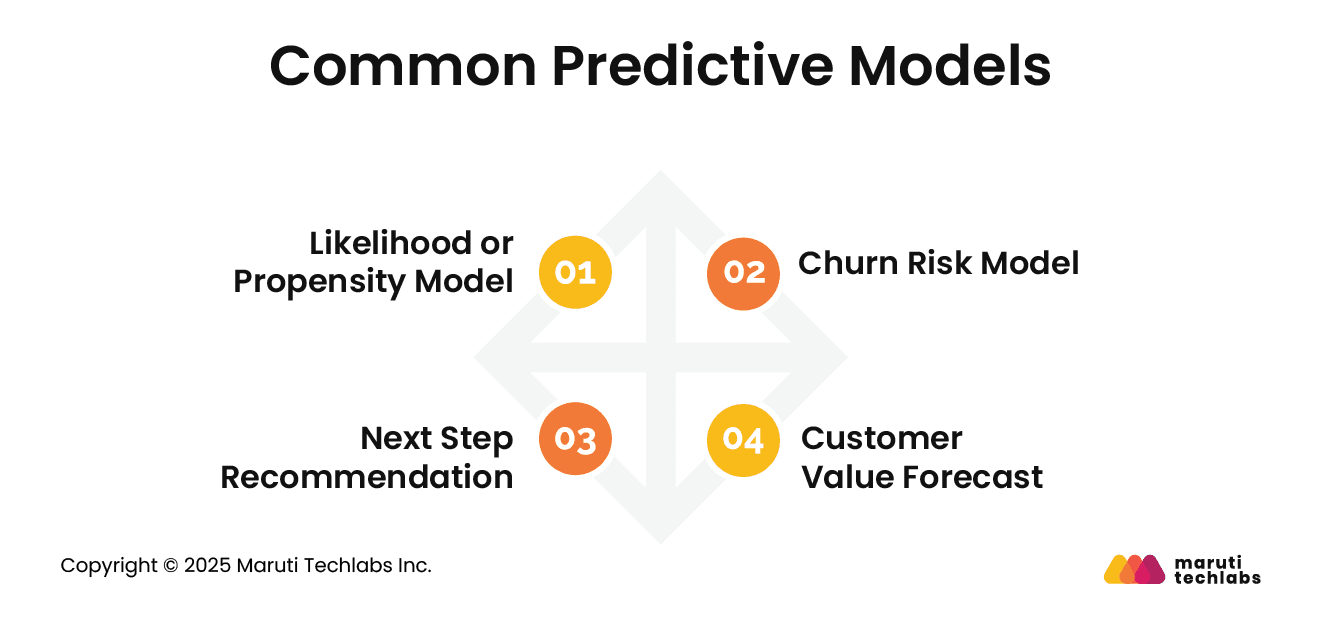
These models help predict the likelihood that a person will take a specific action, such as buying a product, signing up for a service, or clicking an ad. By knowing this, businesses can focus on people who are more likely to respond and create messages that match their interests.
This model identifies customers who may stop using a product or cancel a subscription. By spotting these signs early, businesses can take action, such as offering discounts or enhanced support, to keep customers engaged and reduce churn.
Also known as Customer Lifetime Value (CLV) forecasting, this model helps businesses understand how valuable a customer could be over time. It allows them to focus more on loyal customers, give them personalized rewards, and build stronger relationships.
Often called the Next Best Action model, this approach suggests the next step a business should take for each customer. It could be sending a reminder email, offering a new product, or providing helpful content. The goal is to guide each customer smoothly through their journey in a way that feels natural and personalized.
Using predictive analytics this way helps businesses create smoother, more personal experiences. It leads to happier customers, higher engagement, and better results by turning raw data into thoughtful, human-centered actions.
Predictive analytics adds real value to hyper-personalization. It helps businesses understand what customers want, how they behave, and what keeps them interested. This understanding builds stronger relationships, improves satisfaction, and drives better results.
Here are some of the main benefits predictive analytics offers in hyper-personalization:
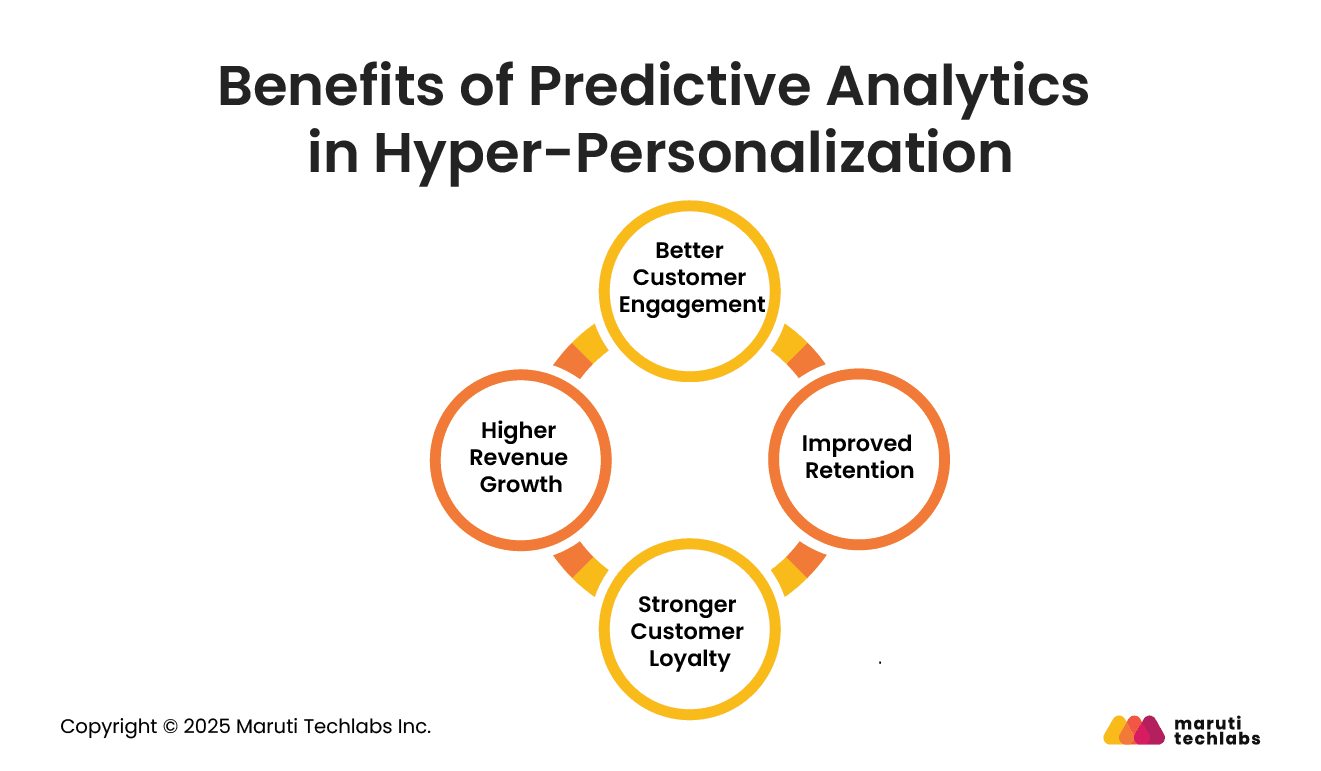
Predictive analytics helps businesses understand customer preferences and predict what they might be interested in next. This allows brands to send messages, offers, or recommendations that feel truly relevant. When people see content that aligns with their interests, they are more likely to click, interact, and stay engaged.
By analyzing behavior patterns, predictive analytics can identify customers who might stop using a service or switch to another brand. This gives businesses a chance to take action early, such as offering support or a special deal to keep them from leaving. This not only reduces customer loss but also saves money on acquiring new customers.
When people feel understood and valued, they tend to stick around longer. Predictive analytics helps create those meaningful moments by personalizing every interaction. Over time, this builds trust and loyalty, turning one-time buyers into long-term customers.
With predictive analytics, businesses can focus their marketing on customers who are most likely to make a purchase or spend more. By tailoring offers and messages to the right audience, companies can boost conversion rates and drive more sales.
The numbers prove its impact. Businesses that use predictive analytics and personalization have seen conversion rates 202% higher and customer satisfaction increase by 56%.
In simple terms, predictive analytics helps companies go beyond guessing. It uses real data to make every customer interaction meaningful, timely, and personal. When done right, it not only improves the customer experience but also drives steady business growth.
Getting started with hyper-personalization can be exciting. To get the best results, it helps to follow a few simple practices.
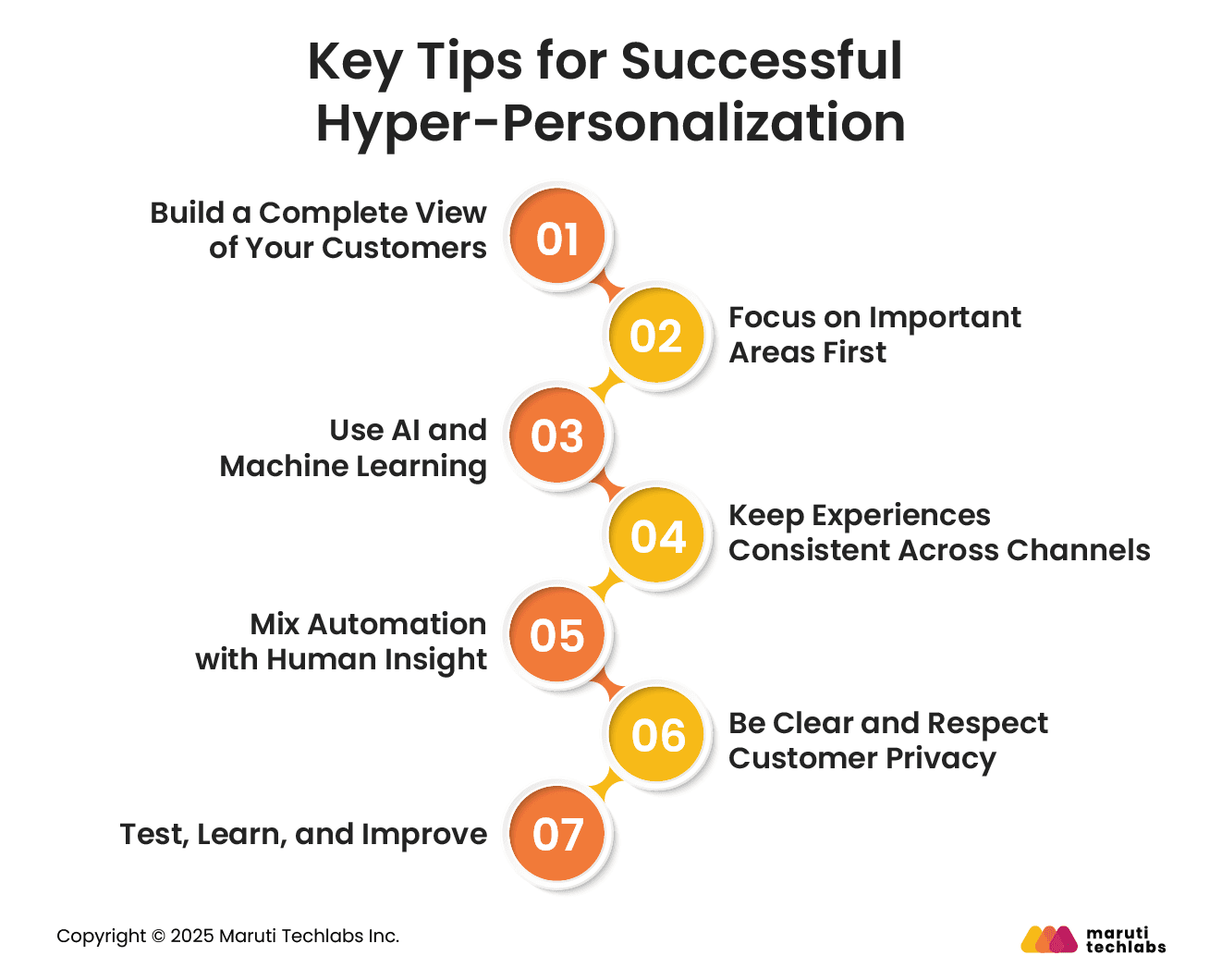
Combine all your customer data in one place. Include profiles, past purchases, browsing history, and interactions. This single view helps you understand each customer and create experiences that feel personal.
Don’t try to personalize everything at once. Start with the touchpoints that matter most, like product recommendations, emails, apps, or websites. This shows the value of hyper-personalization before scaling it further.
Personalization involves a lot of data. AI and machine learning can handle it. They can predict customer behavior, segment audiences, and suggest the best actions. The more data they see, the smarter their recommendations get.
Customers interact with your brand in many ways. Websites, apps, emails, ads, and support calls should all reflect the same understanding of the customer. Consistency makes personalization feel real and reliable.
Automation is helpful, but human expertise matters too. Teams should review and adjust automated experiences when needed. People can notice things that machines might miss.
Be transparent about how you use customer data. Give them control over their settings and listen to their preferences. Honesty builds trust and strengthens relationships.
Hyper-personalization is a process. Try new ideas, check the results, and make improvements. Testing over time helps you create better experiences and get higher engagement.
Even with the best intentions, hyper-personalization can go wrong if you are not careful. Here are some common mistakes and how to avoid them.
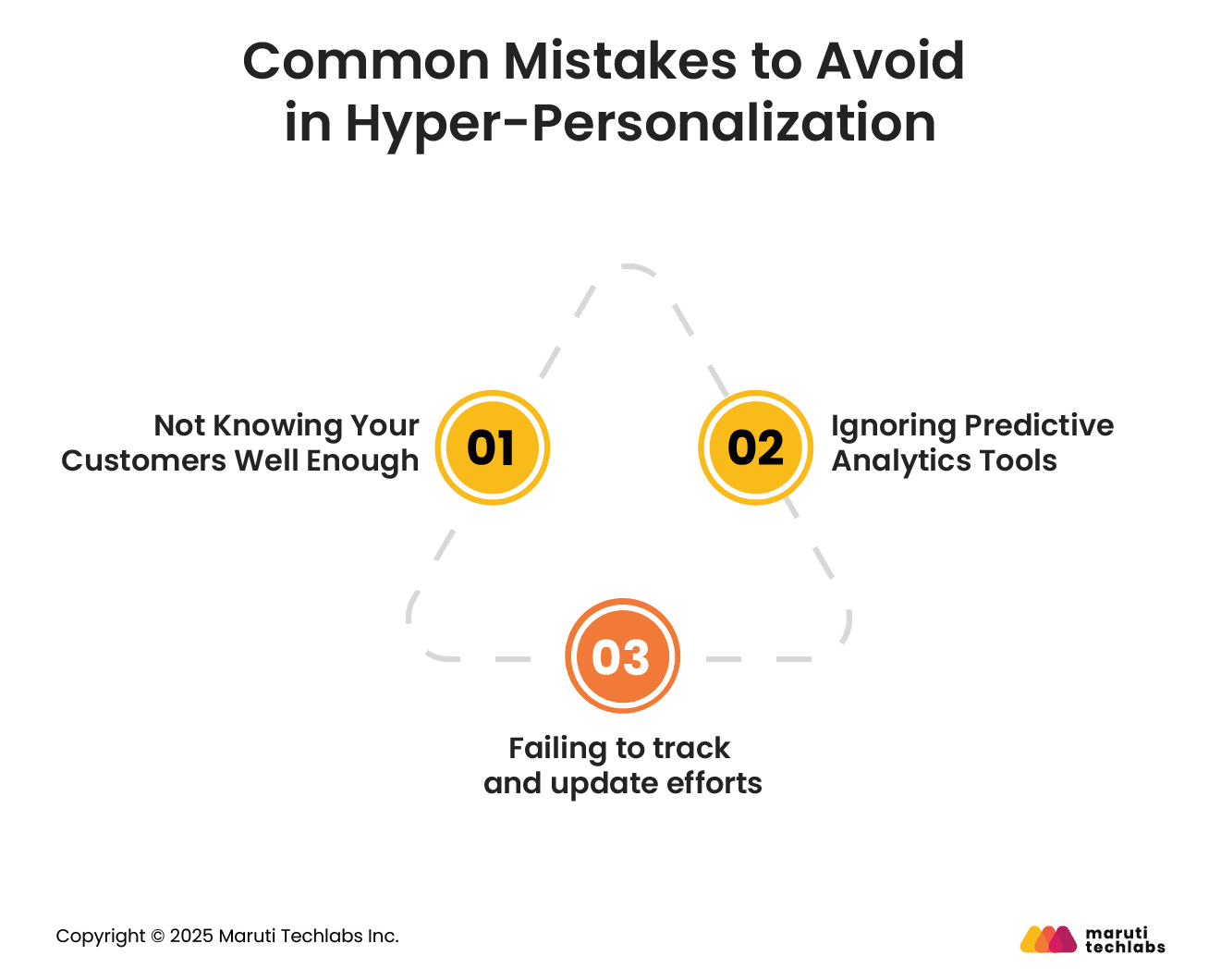
One of the biggest mistakes is starting personalization without really understanding your customers. If you don’t know their preferences, behaviors, or needs, your messages and offers may feel random or irrelevant. Take time to collect and organize your customer data before creating personalized experiences.
Hyper-personalization works best when you use tools that can analyze data and predict customer behavior. Without predictive analytics, it’s hard to know what customers want next or how to reach them effectively. Investing in the right tools makes your personalization smarter and more accurate.
Customer preferences change over time. A personalization strategy that worked last month may not work now. Many businesses fail because they set up personalization once and forget to monitor it. Continuously check results, track engagement, and update your approach to keep experiences relevant and practical.
By avoiding these mistakes, businesses can create hyper-personalized experiences that feel thoughtful, useful, and engaging, leading to happier customers and better results.
Starting hyper-personalization can feel tricky, but breaking it into three steps makes it easier. Here’s a simple 90-day plan:
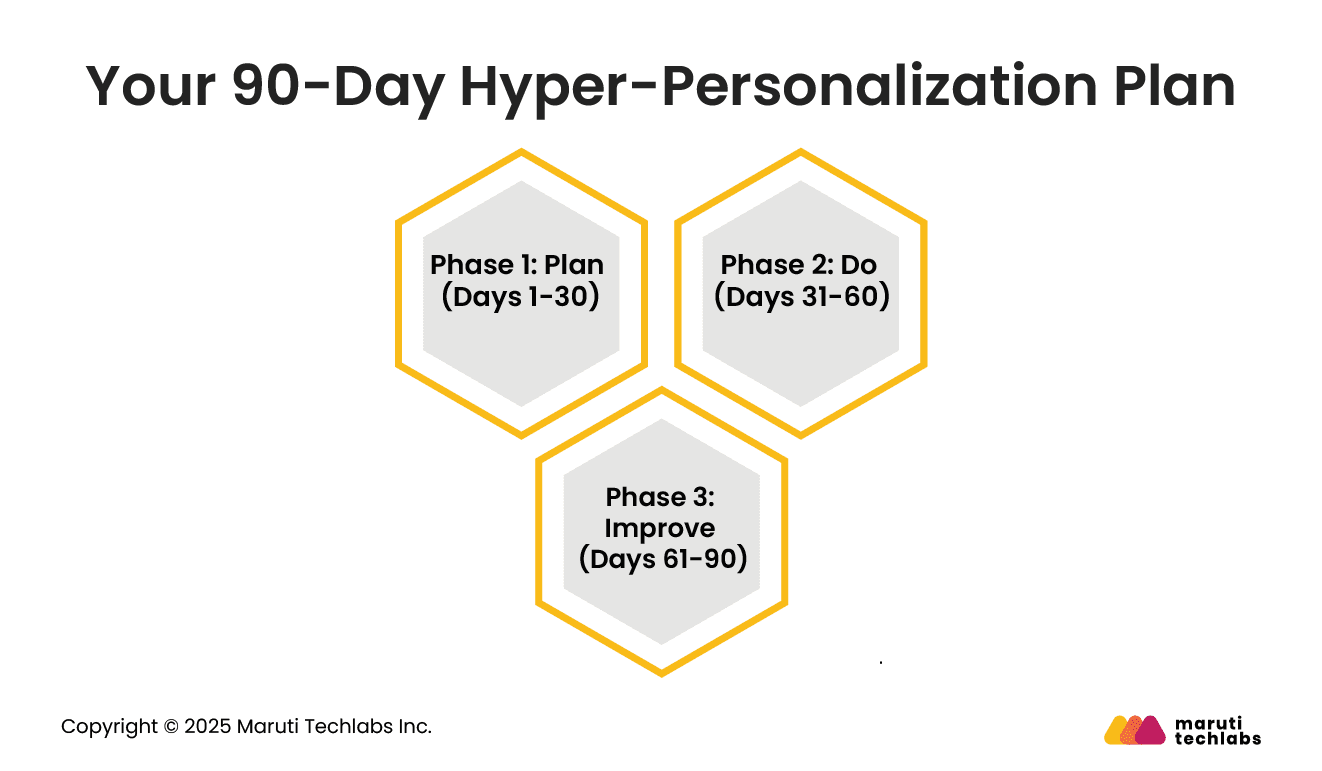
Start by reviewing your existing tools to identify areas where personalization can improve. Define clear customer segments and simple buyer profiles. Plan engaging content, such as quizzes or surveys, to boost interaction. Finally, choose predictive analytics tools like Segment or Twilio to gain deeper customer insights.
Put your plan into action by setting up analytics tools and integrating them with your existing systems. Begin sending personalized content, such as tailored emails or videos, to each customer. Track key metrics such as response rates and customer satisfaction. Use quizzes and surveys to collect feedback and maintain engagement.
Review your results and adjust your approach where needed. Update customer groups and profiles based on new insights. Continue creating fresh personalized content and interactive experiences. Monitor key metrics to track your progress.
By following this simple plan, you can boost conversions, improve customer satisfaction, and reduce churn. Taking small, consistent steps each month helps you create experiences that feel personal and meaningful for every customer.
Hyper-personalization powered by predictive analytics is essential for brands that want to succeed today. It helps businesses understand each customer and deliver experiences that feel personal, useful, and timely. This leads to higher engagement, more conversions, and stronger loyalty.
For companies looking to build advanced personalization engines tailored to their unique customer journeys, Custom AI Development can play a key role in creating scalable, data-driven solutions that deliver highly relevant experiences.
At the same time, it is essential to follow best practices while avoiding common mistakes. Collect and use customer data carefully, be transparent about how it is used, and balance automation with human judgment.
Maruti Techlabs helps businesses create compelling hyper-personalized experiences using AI and predictive analytics. Our solutions are designed to keep customers at the center while driving engagement and growth. To learn more about our AI services or to get in touch with us and see how we can help you implement smart, customer-focused personalization.
If you’re unsure where your organization stands in its AI journey, use our AI Readiness Assessment Tool to evaluate your current capabilities and identify the next steps toward successful AI-driven personalization.
Start by collecting customer data from all touchpoints to understand preferences and behaviors. Use predictive analytics and AI tools to analyze this data. Create tailored content, offers, and recommendations for each customer. Test, monitor, and adjust your strategy regularly to ensure experiences remain relevant and effective.
A key element of hyper-personalization is using real-time data to understand each customer’s unique needs and preferences. This includes tracking behaviors, interactions, and contextual factors such as location or time. The goal is to deliver experiences, messages, and offers that feel personal, timely, and relevant to every individual customer.
AI helps analyze large amounts of customer data quickly. It can predict behaviors, recommend products, segment audiences, and automate personalized messages. By learning from interactions over time, AI makes personalization smarter, allowing businesses to deliver content, offers, and experiences that match each customer’s interests and needs.


